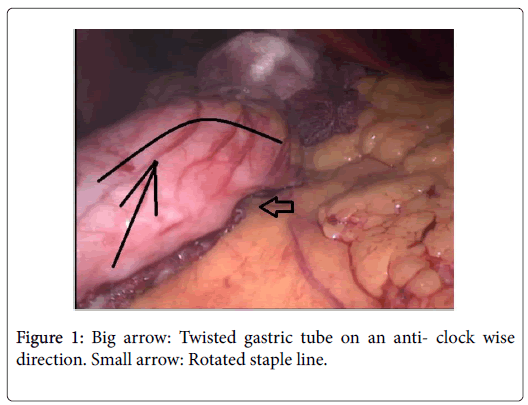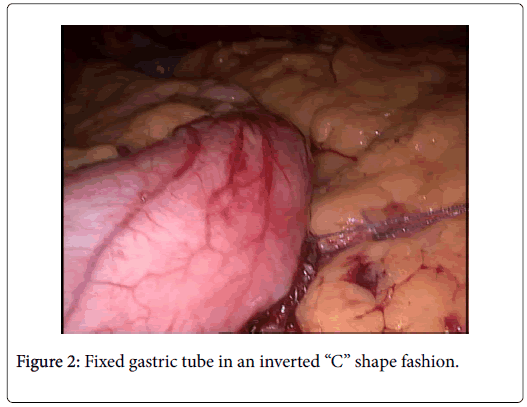A Single Suturing Cancels the Twist
Received: 04-Aug-2018 / Accepted Date: 12-Oct-2018 / Published Date: 19-Oct-2018 DOI: 10.4172/2165-7904.1000376
Keywords: Laparoscopic sleeve gastrectomy; Twisting; Single point fixation; Two minutes method
Introduction
In recent years laparoscopic sleeve gastrectomy has become the leading surgical procedure for morbid obesity. A recent survey showed that the number of LSG performed is 546,368 with a rising incidence reaching 171 548 surgeries in 2013 with an increase of 37% in incidence per year since 2003 [1]. In 2016 LSG has become the most commonly bariatric procedure performed in the world [2]. The most serious complications of LSG are bleeding and leak related mainly to stapling and to the gastric tube shape. Leakage can occur anywhere on the staple line with the most frequent site at the proximal one third [3]. Axial rotation is induced in many cases after the retrieval of the Faucher tube even with a perfect angle control when stapling. Many methods are described in the literature to fix the gastric tube in order to prevent twisting and further complications [4]. We present the case of a single point fixation of the remnant gastric tube with the inner surface of the abdominal wall.
Case Presentation
This is the case of a 26 years old obese female with a BMI of 35 kg/m2 known to have uncontrolled dyslipidemia and hypertension. The patient underwent LSG at our center where an axial rotation of the gastric tube was identified after Faucher tube retrieval and then fixed with a single suture between the twisted gastric tube and the inner abdominal wall. The patient course in hospital was uneventful; and she was discharged on post-operative day 2.
The technique: One suture, lateral fixation
Upon removing the Faucher tube after a classical LSG was performed, an axial rotation of the gastric tube in an anti-clockwise fashion was remarked. We managed to reposition the newly formed gastric tube similar to the physiologic appearance by a single suture. It was made by identifying half distance of the staple line.
Afterwards a single suture was performed by a polysorb 3-0 starting on the identified point on the remnant tube to the abdominal wall facing it. The tension force when doing the node was performed in a way to organize the stomach in an inverted ‘C ’ shape approaching it to the normal anatomical position. The procedure took less than 2 minutes. The staple line was no more inverted (Figures 1 and 2).
Discussion
The stomach is fixed by the gastro-splenic, gastro-hepatic and gastro-colic ligaments. When performing a LSG all those boundaries are lost. Even with a good stapling direction, a gastric tube without boundaries can easily twist immediately when retrieving the faucher. Twisting can also be induced and aggravated after food consuming [5]. In fact, authors recommend fixation of the remnant gastric tube when rotation is noted after LSG. Suturing the remnant tube to the greater omentum was proposed by Santoro in order to regain the normal gastric shape [6]. Baltazar suggested the fixation with the gastro colic ligament after inverting stiches at the staple line [7]. Godoy suggested a double fixation of the proximal and distal staple line. The first one is done by suturing the free edge of the gastro-colic ligament to the proximal staple line near the gastro esophageal junction. In the second one an attachment is formed by the gastro-colic ligament and the gastro-epiploic vessels and the transverse mesocolon beneath the lower edge of the pancreas. This attachment is sutured to the distal part of the staple line in a discontinued form. When suturing both fixations the staple line was inverted [5]. A retrospective study published in July 2016 has shown important results after fixation of the remnant stomach. Two groups were compared in this study with a number of 252 patients in total. One group was operated of LSG without fixation (n=124) and the other group with suturing the remnant stomach to the transverse mesocolon (n=128). The procedure showed significant difference in bleeding (p=0.02), axial rotation (p=0.006) and hospital re-admission (p=0.005). Operative time was shorter in the group without fixation (p=0.04) [4].
Herein we present a simple fixation method that reverses the axial rotation and restores the anatomical gastric shape by less than 2 minutes. Unlike the fixation to the greater omentum which is a mobile structure our technique offers the correction of axial rotation with a solid bond “the abdominal wall ”. In addition our technic offers a safe and rapid fixation away of important structures like the colon and the pancreas.
Conclusion
We offer a rapid and simple technique to cure axial rotation after LSG in order to prevent severe complications such as necrosis and fistulae. A single point fixation from the remnant stomach with the lateral facing abdominal wall is sufficient. This is a single proposition; comparative studies need to be done on this technique in order to evaluate outcomes.
Conflict of Interest
All Authors announce that there is no conflict of interest in this work.
Ethical Approval Statement
All procedures performed in studies involving human participants were in accordance with the ethical standards of the institutional and/or national research committee and with the 1964 Helsinki declaration and its later amendments or comparable ethical standards."
Informed Consent Statement
Does not apply in this case study.
References
- Angrisani L, Santonicola A, Iovino P, Formisano G, Buchwald H, et al. (2015) Bariatric surgery Worldwide 2013. Obes Surg 25: 1822-1832.
- Sepulveda M, Astorga C, Hermosilla JP, Alamo M (2014) Staple line reinforcement in laparoscopic sleeve gastrectomy: Experience in 1023 consecutive cases. Obes Surg 27: 1474-1480.
- Abdallah E, Emile SH, Elfeki H (2017) Laparoscopic sleeve gastrectomy with or without staple line inversion and distal fixation to the transverse mesocolon: Impact on early postoperative outcomes. Obes Surg 27: 323-329.
- de Godoy EP, Coelho D (2013) Gastric sleeve fixation strategy in laparoscopic vertical sleeve gastrectomy. Arq Bras Cir Dig ABCD Braz Arch Dig Surg 26: 79-82.
- Santoro S (2007) Technical aspects in sleeve gastrectomy. Obes Surg 17: 1534-1535.
- Baltasar A (2011) Laparoscopic sleeve gastrectomy with partial antrectomy and omental patch. BMI 1: 1-2.
Citation: Nehmeh WA, Gharios J, Alameh A, Noun R (2018) A Single Suturing Cancels the Twist. J Obes Weight Loss Ther 8: 376. DOI: 10.4172/2165-7904.1000376
Copyright: © 2018 Nehmeh WA, et al. This is an open-access article distributed under the terms of the Creative Commons Attribution License, which permits unrestricted use, distribution, and reproduction in any medium, provided the original author and source are credited.
Select your language of interest to view the total content in your interested language
Share This Article
Recommended Journals
Open Access Journals
Article Tools
Article Usage
- Total views: 4222
- [From(publication date): 0-2018 - Oct 10, 2025]
- Breakdown by view type
- HTML page views: 3343
- PDF downloads: 879


